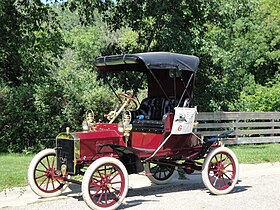| Ford Model N | |
|---|---|
 | |
| Overview | |
| Manufacturer | Ford Motor Company |
| Also called | Model R Model S |
| Production | 1906–1908 |
| Designer | Henry Ford |
| Body and chassis | |
| Class | Entry-level |
| Body style | 2-row phaeton |
| Powertrain | |
| Engine | 149 cu in (2,440 cc) 15 hp (11 kW; 15 PS) Model N[1][2][3] straight-4 |
| Transmission | 2-speed planetary[2][3] |
| Dimensions | |
| Wheelbase | 84 in (213 cm) |
| Curb weight | 800 lb (363 kg) (1906); 1,050 lb (476 kg) (1907 Model N); 1,400 lb (635 kg) (1907 Models R and S)[2] |
| Chronology | |
| Predecessor | Ford Model F |
| Successor | Ford Model T |
The Ford Model N is an automobile produced by Ford Motor Company; it was introduced in 1906 as a successor to the Models A and C as the company's inexpensive, entry-level line. It was built at the Ford Piquette Avenue Plant.
The Model N diverged from its predecessors in that it was a front-engine car with a four-cylinder engine. The 15 hp straight-four drove the rear wheels via a long shaft. This was also the first American car to use vanadium steel.[4] The car had a wheelbase of 84 in (2,100 mm).
A successful model, 7000 cars were made before production ended in 1908. At US$500, the car was viewed as highly affordable at the time; by contrast, the high-volume Oldsmobile Runabout went for $650,[5] Western's Gale Model A was $500,[6] the Brush Runabout $485,[7] the Black $375,[8] and the Success for $250.[5] Maroon was the only factory color for the Model N.[3]
- ^ Boggess, Trent. "1907 Model N Ford Engine". Retrieved 2015-03-31.
- ^ a b c Kimes, Beverly (1996). Standard Catalog of American Cars 1805-1942. Krause Publications. ISBN 0-87341-428-4.
- ^ a b c "1906 Ford Advance Brochure". The Old Car Manual Project. Retrieved 2015-03-31.
- ^ Lacey, Robert (1986). Ford: The Men and the Machine. ISBN 0-316-51166-8.
- ^ a b Clymer, Floyd. Treasury of Early American Automobiles, 1877-1925. New York: Bonanza Books, 1950., p. 32.
- ^ Clymer, Floyd. Treasury of Early American Automobiles, 1877-1925. New York: Bonanza Books, 1950. , p. 51.
- ^ Clymer, Floyd. Treasury of Early American Automobiles, 1877-1925. New York: Bonanza Books, 1950. , p. 104.
- ^ Clymer, Floyd. Treasury of Early American Automobiles, 1877-1925. New York: Bonanza Books, 1950., p. 61.